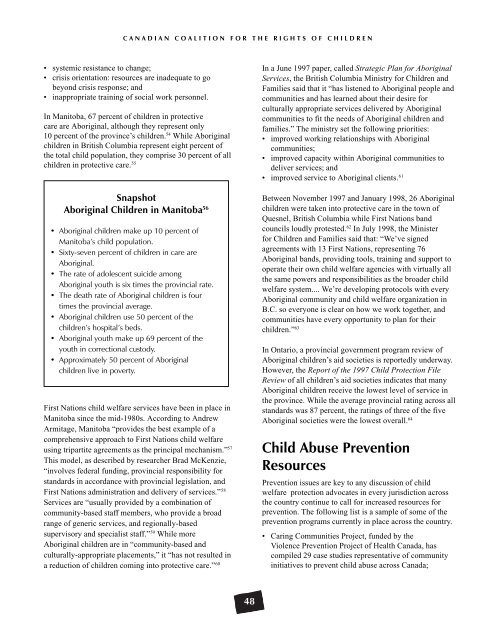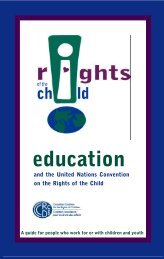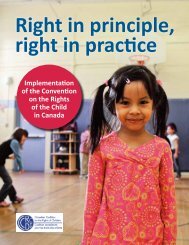Poste - Canadian Coalition for the Rights of Children
Poste - Canadian Coalition for the Rights of Children
Poste - Canadian Coalition for the Rights of Children
You also want an ePaper? Increase the reach of your titles
YUMPU automatically turns print PDFs into web optimized ePapers that Google loves.
C A N A D I A N C O A L I T I O N F O R T H E R I G H T S O F C H I L D R E N<br />
• systemic resistance to change;<br />
• crisis orientation: resources are inadequate to go<br />
beyond crisis response; and<br />
• inappropriate training <strong>of</strong> social work personnel.<br />
In Manitoba, 67 percent <strong>of</strong> children in protective<br />
care are Aboriginal, although <strong>the</strong>y represent only<br />
10 percent <strong>of</strong> <strong>the</strong> province’s children. 54 While Aboriginal<br />
children in British Columbia represent eight percent <strong>of</strong><br />
<strong>the</strong> total child population, <strong>the</strong>y comprise 30 percent <strong>of</strong> all<br />
children in protective care. 55<br />
Snapshot<br />
Aboriginal <strong>Children</strong> in Manitoba 56<br />
• Aboriginal children make up 10 percent <strong>of</strong><br />
Manitoba’s child population.<br />
• Sixty-seven percent <strong>of</strong> children in care are<br />
Aboriginal.<br />
• The rate <strong>of</strong> adolescent suicide among<br />
Aboriginal youth is six times <strong>the</strong> provincial rate.<br />
• The death rate <strong>of</strong> Aboriginal children is four<br />
times <strong>the</strong> provincial average.<br />
• Aboriginal children use 50 percent <strong>of</strong> <strong>the</strong><br />
children’s hospital’s beds.<br />
• Aboriginal youth make up 69 percent <strong>of</strong> <strong>the</strong><br />
youth in correctional custody.<br />
• Approximately 50 percent <strong>of</strong> Aboriginal<br />
children live in poverty.<br />
First Nations child welfare services have been in place in<br />
Manitoba since <strong>the</strong> mid-1980s. According to Andrew<br />
Armitage, Manitoba “provides <strong>the</strong> best example <strong>of</strong> a<br />
comprehensive approach to First Nations child welfare<br />
using tripartite agreements as <strong>the</strong> principal mechanism.” 57<br />
This model, as described by researcher Brad McKenzie,<br />
“involves federal funding, provincial responsibility <strong>for</strong><br />
standards in accordance with provincial legislation, and<br />
First Nations administration and delivery <strong>of</strong> services.” 58<br />
Services are “usually provided by a combination <strong>of</strong><br />
community-based staff members, who provide a broad<br />
range <strong>of</strong> generic services, and regionally-based<br />
supervisory and specialist staff.” 59 While more<br />
Aboriginal children are in “community-based and<br />
culturally-appropriate placements,” it “has not resulted in<br />
a reduction <strong>of</strong> children coming into protective care.” 60<br />
48<br />
In a June 1997 paper, called Strategic Plan <strong>for</strong> Aboriginal<br />
Services, <strong>the</strong> British Columbia Ministry <strong>for</strong> <strong>Children</strong> and<br />
Families said that it “has listened to Aboriginal people and<br />
communities and has learned about <strong>the</strong>ir desire <strong>for</strong><br />
culturally appropriate services delivered by Aboriginal<br />
communities to fit <strong>the</strong> needs <strong>of</strong> Aboriginal children and<br />
families.” The ministry set <strong>the</strong> following priorities:<br />
• improved working relationships with Aboriginal<br />
communities;<br />
• improved capacity within Aboriginal communities to<br />
deliver services; and<br />
• improved service to Aboriginal clients. 61<br />
Between November 1997 and January 1998, 26 Aboriginal<br />
children were taken into protective care in <strong>the</strong> town <strong>of</strong><br />
Quesnel, British Columbia while First Nations band<br />
councils loudly protested. 62 In July 1998, <strong>the</strong> Minister<br />
<strong>for</strong> <strong>Children</strong> and Families said that: “We’ve signed<br />
agreements with 13 First Nations, representing 76<br />
Aboriginal bands, providing tools, training and support to<br />
operate <strong>the</strong>ir own child welfare agencies with virtually all<br />
<strong>the</strong> same powers and responsibilities as <strong>the</strong> broader child<br />
welfare system.... We’re developing protocols with every<br />
Aboriginal community and child welfare organization in<br />
B.C. so everyone is clear on how we work toge<strong>the</strong>r, and<br />
communities have every opportunity to plan <strong>for</strong> <strong>the</strong>ir<br />
children.” 63<br />
In Ontario, a provincial government program review <strong>of</strong><br />
Aboriginal children’s aid societies is reportedly underway.<br />
However, <strong>the</strong> Report <strong>of</strong> <strong>the</strong> 1997 Child Protection File<br />
Review <strong>of</strong> all children’s aid societies indicates that many<br />
Aboriginal children receive <strong>the</strong> lowest level <strong>of</strong> service in<br />
<strong>the</strong> province. While <strong>the</strong> average provincial rating across all<br />
standards was 87 percent, <strong>the</strong> ratings <strong>of</strong> three <strong>of</strong> <strong>the</strong> five<br />
Aboriginal societies were <strong>the</strong> lowest overall. 64<br />
Child Abuse Prevention<br />
Resources<br />
Prevention issues are key to any discussion <strong>of</strong> child<br />
welfare protection advocates in every jurisdiction across<br />
<strong>the</strong> country continue to call <strong>for</strong> increased resources <strong>for</strong><br />
prevention. The following list is a sample <strong>of</strong> some <strong>of</strong> <strong>the</strong><br />
prevention programs currently in place across <strong>the</strong> country.<br />
• Caring Communities Project, funded by <strong>the</strong><br />
Violence Prevention Project <strong>of</strong> Health Canada, has<br />
compiled 29 case studies representative <strong>of</strong> community<br />
initiatives to prevent child abuse across Canada;




